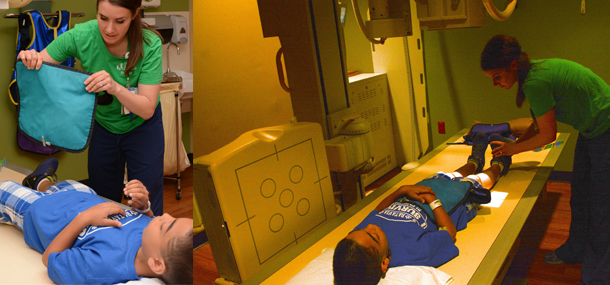
When we take an x-ray, we use radiation to generate a picture. While radiation is around us each day, it is important to limit exposure when possible. Lead has the unique ability to stop the penetration and scatter of the x-ray beam to the patient, family members, staff, and general public. In the Radiology Department there are lead-lined walls, doors and ceilings to protect the general public. This helps block any unnecessary exposure that may occur from radiation-generating equipment.
At Cincinnati Children’s, we have a few unique characteristics that keep our radiation doses lower than other institutions. First, our equipment is specifically designed for pediatrics, which allows us to use a smaller amount of radiation from the start. Secondly, you will notice your child being measured for each image that your doctor has requested. Measuring gives the technologists the tools to select the right technique for each individual child, ensuring the smallest amount of radiation is given to produce a high-quality image. Finally, you will see a lead apron or gonad shield placed on your child as additional protection to the most radiosensitive body parts: the reproductive organs. We also provide you and other family members with lead aprons to wear if you will be staying in the room. We welcome anyone 18 years and older who offers additional support to your child in the exam room.
 Photo: Measuring to ensure the smallest amount of radiation, but also ensures a high quality image.
Photo: Measuring to ensure the smallest amount of radiation, but also ensures a high quality image.
Different types of shields you may see are half lap aprons, lead in the shape of hearts, rolling lead shields, and small rad pads in the NICU. The technologist will select the appropriate shield for the exam ordered, views requested and gender and size of the patient.
As lead is stopping the beam of the x-ray, some exams can’t be performed with a shield because it will block important anatomy that the radiologist needs to see. It is difficult to shield areas of the lower extremity, abdominal region, and the thyroid area if this is the area that needs to be examined. Other types of these exams include the chest, female abdomen, views of the hips and pelvis, scoliosis series, and trauma imaging. Our technologists make every effort to ensure your child is receiving the smallest dose possible while providing a quality image for the doctors.
Contributions by Erin Adkins (RT-X-ray) and edited by Wendy Bankes.